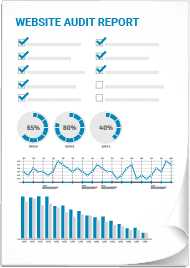Imagine standing at the edge of a digital transformation, ready to **revamp a website**. Embarking on this adventure means more than just refreshing your site’s look; it involves a deep dive into reinventing the way you engage with visitors, amplify your reach, and elevate the number of successful interactions.
This manual will explore the deeper rationale behind revamping your website’s layout, emphasizing that it transcends mere visual appeal to encompass strategic significance. In our next step, we’re diving into the art of crafting specific objectives for your website makeover and harnessing the power of data analysis through platforms such as Google Analytics to guide your choices. Additionally, you’ll uncover strategies to elevate the user experience (UX), a crucial step in converting casual browsers into dedicated patrons.
Join me as we dive into the journey of morphing your site into a dynamic beacon for expansion, revealing how to harness its full potential.
Table of Contents:
- Understanding the Need for a Website Revamp
- Planning Your Website Redesign Strategy
- Analyzing Current Website Performance
- Enhancing User Experience (UX) Design
- Optimizing Content and SEO Strategies
- The Technical Side of a Website Revamp
- Increasing Traffic Through SEO Improvements
- Header Security Measures in Modern Web Design
- Incorporating Multimedia Elements
- Conclusion
Understanding the Need for a Website Revamp
Revamping your website isn’t just about slapping on a fresh coat of paint. It’s about ensuring that your online presence doesn’t look like it belongs in the internet Stone Age. Let’s be real, an existing website that hasn’t seen updates in years probably screams “dinosaur” more than “dynamic.”
Signs That Your Website Needs a Revamp
If you’re greeting visitors with outdated content, unappealing design, or broken elements, it’s time to consider a redesign. Think of your current website as your digital storefront; if customers walk by and see broken windows (links) and faded signs (graphics), they’re less likely to step inside.
Beyond aesthetics, think about improve website functionality: Can users easily navigate through pages? Is information easy to find? A confusing layout is like having an unkempt store where everything’s out of place – not exactly inviting for potential customers looking for specific products or services.
Benefits of Revamping Your Website
A well-executed site redesign can breathe new life into your web presence. Upgrading the user’s journey makes them linger, delighted by smooth navigation and captivating material. This enhanced interaction often leads to better conversion rates as visitors are more likely to make purchases or sign up for newsletters when they appreciate the ease-of-use and modern feel of a revamped site.
The cherry on top? An updated aesthetic paired with streamlined functionality positions you ahead in search engine rankings because Google loves websites that provide excellent user experiences almost as much as users do.
Planning Your Website Redesign Strategy
Setting Clear Redesign Goals
Before picking out the shades and typefaces for your site, it’s essential to firmly establish the objectives you aim to achieve with this makeover. Are we looking to boost our conversion rates or maybe increase traffic? Maybe we’re aiming to enhance the overall vibe on our site, making it a place where folks feel inclined to linger a bit more. Whatever it is, defining these goals early on guides every decision in the revamp process.
To make sense of this, let’s use Google Analytics. It helps us track everything from bounce rates to organic traffic patterns. These insights reveal where your current site might be dropping the ball and how a redesign could pick it up.
Delving beyond mere visual appeal, think about how revamping your site’s appearance can fundamentally boost aspects such as lead acquisition or simplify the process of form submissions to elevate user interaction. We’re not merely focusing on cosmetics here; we’re crafting a system that operates with greater efficiency.
Analyzing Current Website Performance
A good look under the hood with tools like Google Analytics shows us not just who visits but how they interact with our content. Do pages load quickly enough? Are mobile users bouncing because the site doesn’t play nice with their devices?

Exploring data like the bounce rate of first-time visitors unveils where we must prioritize enhancements with haste. Maybe those long loading times are sending potential customers running before they even see what you offer.
This analysis lays down solid data-driven objectives for your redesign strategy – aiming not only for looks but performance that matches today’s fast-paced digital world expectations.
Analyzing Current Website Performance
Utilizing Google Analytics to Monitor Bounce Rates and Organic Traffic Patterns
Grasping your site’s position necessitates delving into indicators such as the frequency of visitors departing after a single page and the natural flow of user visits. Bounce rate tells you how many visitors leave after viewing just one page. A high number might mean your site isn’t what they expected or it’s too complex to navigate. You can find this crucial stat in Google Analytics – Bounce Rate.
Moving forward, we’ll dive into the essence of organic traffic. Our gauge here tallies the influx of guests directed by web searches. This metric is invaluable for gauging whether your online material aligns with the queries and interests of web searchers.
By observing these metrics regularly, you’re essentially unlocking a treasure trove of knowledge on whether your website’s layout is truly resonating with what visitors are seeking. Maybe those long load times are turning potential leads away before they even see what you have to offer, or perhaps your SEO game needs stepping up to increase visibility on search engine results pages (SERPs). Either way, these figures don’t lie.
Enhancing User Experience (UX) Design
The success of a website hinges on the user experience, akin to the spinal column that supports and connects its various parts. Navigating your website should evoke the same joy and ease as a guest feels wandering through a welcoming home. Think of it as hosting guests; you want them to have such a good time that they can’t wait to come back.
Streamlining Navigation
Enhancing user interaction and driving up conversion rates hinges on the crucial act of refining your website’s navigation structure. An overloaded menu might perplex your audience, increasing the chances they’ll exit your page without interacting with what you offer. This directly impacts not just user satisfaction but also navigation speed – an essential factor in today’s fast-paced digital world.
Crafting a menu with clear organization not only simplifies the search process for users but also ensures they effortlessly locate their desired content or products. But don’t take our word for it; Google Analytics shows us that improving navigational elements can significantly reduce bounce rates while increasing organic traffic patterns—a clear win-win.
Adapting to these shifts goes beyond merely staying trendy; it’s a recognition of the global web audience’s dynamic needs and desires. With every tweak aimed at enhancing UX, you’re essentially rolling out the red carpet for potential customers, guiding them smoothly from point A to B on their buyer journey.
Optimizing Content and SEO Strategies
Revamping your site isn’t just about a fresh coat of paint. It’s about making sure people actually find and love that new look. That’s where updating content and tweaking SEO rankings come into play.

Updating Content
Your website is like a garden; it needs regular tending to flourish. If you’ve let weeds take over (think outdated info or stale blog posts), visitors won’t want to stick around, no matter how pretty the flowers are. A content calendar can be your gardening schedule, ensuring you regularly plant new seeds of information that will attract more visitors.
So, it’s about circling back to outdated content for a refresh, weaving in new perspectives on timeless subjects, or trimming parts that don’t align with your brand’s narrative anymore.
SEO Rankings
You’ve updated the content; now let’s make sure Google notices. Search engine optimization is all about speaking Google’s language but think less high school French class struggle and more getting directions from a local in Paris effortlessly because you know just enough key phrases.
Incorporating keywords naturally within your content helps search engines understand what each page on your site is about so they can direct users right to it when they’re searching for those terms. Delving into the nuances of your website’s current stats with tools such as Google Analytics, especially focusing on bounce rates and patterns of natural visitors, offers critical clues on how minor adjustments could significantly enhance its online presence.
The Technical Side of a Website Revamp
Revitalizing your site goes beyond aesthetic enhancements; it’s about meticulously enhancing its core mechanics to ensure seamless operation. Optimizing how quickly your pages load and guaranteeing they work well on phones is essential to maintain visitor satisfaction and attention.
Implementing Responsive Design
In today’s world, if your site can’t smoothly transition from desktop to smartphone, you’re in trouble. That’s why adopting responsive web design techniques is non-negotiable. This approach lets your site adjust seamlessly across all devices, enhancing user experience dramatically.
A snappy website keeps people around longer. Studies show that even a one-second delay in page response can lead to a 7% reduction in conversions. To tackle this issue, prioritize streamlining visuals, maximizing cache utility, and refining the code for CSS and JavaScript to enhance those vital loading speeds.
So, what’s the trick to figuring out whether these tweaks are genuinely enhancing your site’s performance? Tools like Google Analytics come into play here by helping monitor bounce rates and organic traffic patterns before and after the revamp (Google Analytics – Bounce Rate). By analyzing these indicators, we gain a lucid understanding of the areas requiring enhancement and where our hard work is bearing fruit.
Wrapping it up, on the tech front of giving your site a makeover, look past just looks; ponder how making it responsive can broaden its reach across gadgets and concentrating on slashing loading periods can captivate visitors more—key to maintaining an edge in the digital arena.
Increasing Traffic Through SEO Improvements
If you’ve ever wondered how to make your site a magnet for search engines, buckle up. Prepare to plunge into the realm of SEO enhancements, where we don’t merely boost visits but metamorphose your site into a prime destination for your intended viewers.
Optimizing Your Site’s Content and Structure
To kick things off, let’s talk content because it’s king in the realm of SEO. Revamping your website’s content goes beyond merely keeping it current; it plays an essential role in sustaining top-tier search engine visibility. This means scrutinizing every word on your page and asking yourself if it speaks directly to what people are searching for online.
Not only do the words matter, but how they’re arranged is equally significant. A well-organized site helps visitors find what they need fast which Google loves seeing. Imagine a website where navigating feels like gliding through water, with menus so smooth and design so intuitive that it not only elevates your browsing pleasure but also lifts the site’s visibility on search engines.
The Technical Backbone: Speed and Mobile Responsiveness
Moving onto technical territory now—speed is non-negotiable. In an age where patience wears thin quickly, ensuring swift load times can keep potential bouncers glued to your pages longer than you’d think possible.
Equally critical is mobile responsiveness since more searches happen on smartphones than ever before—a trend showing no signs of slowing down. Making sure everyone can access and navigate your site regardless of device ensures not only better user experiences but also stronger standings in search results thanks to Google’s mobile-first indexing approach.
Header Security Measures in Modern Web Design
In today’s digital age, the importance of integrating robust security features during a website revamp cannot be overstated. Protecting both users’ data and business integrity is paramount.
One crucial step is implementing HTTPS to ensure secure communication over the network. By safeguarding your website with HTTPS, not only do you shield it from possible dangers, but you also elevate its visibility on search engines since Google favors sites that are secure.
Integrating testing grounds for evaluating fresh scripts or functionalities stands as another essential safeguard. Sandboxes act as a safety net, preventing untested code from affecting your live site’s performance or security. More about this can be found at TechTarget’s definition of sandbox.
The Role of Security Plugins
Boosting your site’s guard against online dangers significantly requires the integration of robust security add-ons. Incorporating these instruments, which range from malware detection to firewall implementation and safeguards against forceful entry attempts, significantly bolsters the protective measures of your online domain.
In addition to employing plugins, consistently updating every element of your website plays a pivotal role in upholding robust security measures. Neglected themes or plugins could become gateways for cybercriminals to unearth and manipulate weaknesses in your network.
Last but not least is educating yourself and staying updated on the latest cybersecurity trends and threats because knowledge truly is power when it comes to safeguarding online assets.
Incorporating Multimedia Elements
Imagine a world where websites are more than just text on a screen. By weaving videos and pictures into the fabric of your website, you unlock a realm where your site’s design transcends mere words. Adopting this approach doesn’t just make your site more visually attractive; it profoundly deepens the level of interaction users have with it.

Videos: The Game Changer
Integrating video content can transform the static nature of your website into an interactive experience. Incorporating videos into your online presence not only simplifies the transmission of intricate details through tutorials, demonstrations, or glimpses into organizational ethos but also transforms your website into a more engaging and interactive platform.
Beyond their informational value, videos contribute to SEO efforts by increasing time spent on pages—a key metric Google considers when ranking sites. Remember that quality matters as much as quantity; poorly produced videos might do more harm than good.
Images: Worth a Thousand Words
Pictures can tell stories faster and often more effectively than paragraphs of text. Whether it’s showcasing products or highlighting team members, high-quality images help break up large blocks of text and add personality to your site.
To maximize impact while maintaining fast load times—an essential factor for mobile responsiveness—optimize all photos before uploading them onto your site. Striking the perfect harmony between visual appeal and operational efficiency is key to captivating your audience without subjecting them to tedious loading periods.
A well-thought-out combination of multimedia elements not only enriches visitor experience but also serves vital SEO purposes by encouraging longer visits and better interaction rates—all keys to climbing higher in search rankings.Learn how these strategies fit into overall web design principles here.
Conclusion
Revamping a website is more than just an update; it’s a rebirth. Discovering the power of keeping up-to-date and refining how users interact with your site can majorly uplift participation.
Setting clear goals and using data from tools like Google Analytics help steer your redesign in the right direction. Keep in mind, making navigation straightforward improves how easy it is to use.
Crafting content and optimizing for search engines go beyond mere trendy terms; they are essential elements in boosting your online presence. Make sure to streamline load times and ensure mobile responsiveness for peak performance.
Incorporating multimedia elements not only catches the eye but also keeps visitors hooked. Safeguarding your efforts and the confidence of your viewers is ensured through robust security protocols.
To sum up, revamp with purpose, design with data, optimize relentlessly, secure fiercely, engage visually. Let these steps guide you to a site that doesn’t just look better—it performs better too.




